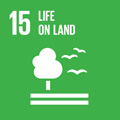- Docente: Michele Mattetti
- Credits: 6
- SSD: AGR/09
- Language: Italian
- Teaching Mode: Traditional lectures
- Campus: Bologna
- Corso: Second cycle degree programme (LM) in Planning and management of agro-territorial, forest and landscape (cod. 8532)
Learning outcomes
At the end of the course, students will know all the principles of
geotechnical engineering and they will be able to apply such
knowledge for the design and protection of land resources.
Course contents
Lectures (36 hours):
- Basic
phisics :
Definitions of force, moment, static equilibrium. - Soil classification;
- Atterberg's limits:
Liquid limit, plastic limit, shrinkage limit, plastic index, clay activity index, plasticity chart, determination of liquid limit by Casagrande's spoon and conepenotrometer , determination of plastic limit. - Soil elasticity:
Young's modulus, Poisson's coefficient, shear modulus - Mohr's circle:
Principal directions. - Shear
strenght :
Coulomb failure line, soil friction angle, cohesion, Mohr-Coulomb failure criteria. - Soil strains:
Consolidation, compaction. - Soil shear testing in laboratory:
Triaxial test (CD, CU, UU), direct shear test.
- Lateral earth pressure:
Active, passive and at restcondtions according to Raking and Coulomb theories. - Slopes stability:
Stability ofunfinite slope for cohesionless soils and cohesive soils,stability of finite slopes. - Shallow foundations:
Failures of shallow foundations, bearing capacity of soils with Terzaghi's formula, safety factor calculation of shallow foundations. - Design of sheet piles and gabion walls.
Exercises (24 hours):
- Soil sampling: Soil samples will be collected in unstable slope.
- Measurement of Atterberg's limits;
- Mini excel course.
- Slope stability:
Introduction toSSAP software. - Design of retaining walls:
Design of gravity walls, gabions, sheet piles and cantilever walls with MS Excel.
Readings/Bibliography
- PDF notes provided by the teacher. To aid
class learning process, these notes should be printed before each lecture. These notes will be provided with IOL service and they will be accessible to those subscribed to the distribution list. - Budhu, Muni - Soil mechanics and foundations - John Wiley & Sons, 2008.
- Luigi Maurizio Paternò - La
relazione geologica esempi
Discretionary course material:
- J. Facciorusso – Dispense di Geotecnica – Università di Firenze download link: http://people.dicea.unifi.it/johannf/?page=support_geot.
- John Atkinson - Fundamentals of ground engineering - CRC Press.
- Whitlow, Roy- Basic soil mechanics - Longman, 1990.
- Piergiuseppe Froldi - Dissesto idrogeologico e stabilità dei versanti. Consolidamento dei pendii con palificate. Analisi e progettazione - Maggioli Editore, 2015.
- Materials useful for the design of slope retaining structures will be provided through the AMS Campus service.
The details of the distribution list can be requested by email
"Lista di
Teaching methods
Lectures in class, in soil mechanics and computer laboratories. To take part of the soil mechanics laboratory, it is mandatory to attend preemptively to attend the safety course.
During the course, seminars will be planned and will be held by experts in the field of slope stabilization.
Assessment methods
The course is a module of "Agro-Forestry Hydraulic Systems" together with the course of "Hydraulic Agro-Forestry". Consequently, the final assessment will be the average value of the single assessment of each course.
For this module, the final exam will consist in an oral examination where there are three questions and one will be on the stability analysis of earth ground structures.
The online exam confirmation is mandatory. Considering that is a module, the recording Teacher is
Students wishing to take the examination in English are allowed
Teaching tools
Lectures in class, soil testing laboratory and in computer
lab.
Office hours
See the website of Michele Mattetti
SDGs



This teaching activity contributes to the achievement of the Sustainable Development Goals of the UN 2030 Agenda.
